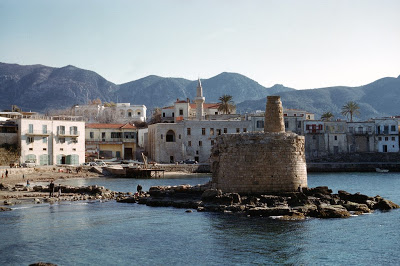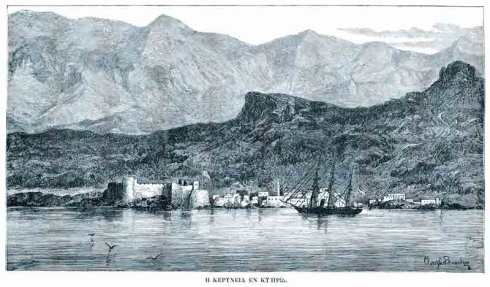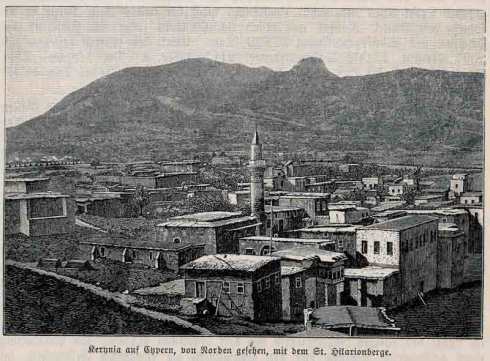Η Κερύνεια
Η γραφική πόλη της Κερύνειας ιδρύθηκε στην αρχαιότητα από τον Κηφέα σε παράλιο περιοχή, στους πρόποδες της οροσειράς του Πενταδακτύλου. Όπως και άλλοι Ελληνικοί οικισμοί στο νησί η πολίχνη συνδύαζε την φυσική ομορφιά της θάλασσας και του βουνού και μέσω του περάσματος στο βουνό είχε πρόσβαση στην πεδιάδα της Μεσαορίας.
Αρκετοί αρχαίοι συγγραφείς και επισκέπτες είχαν εντυπωσιασθεί από την Κερύνεια. Ο Στράβων, ο μεγάλος γεωγράφος και ταξιδιώτης γράφει για τα βουνά της Κερύνειας και την πλούσια βλάστηση τους. Το 1211 μ.Χ. ο Γερμανός ταξιδιώτης Wilbrand von Ollenburg που αποβιβάστηκε στην Κερύνεια την περιγράφει σαν ένα μαγευτικό και γραφικό οικισμό.
Κατά την περίοδο των Λουζινιανών και Ενετών η Κερύνεια μεγάλωσε σε πληθυσμό και πλούτο αλλά η τύχη της ήταν συνδεδεμένη με τους αγώνες για την εξουσία μεταξύ βασιλικών οίκων και μεταξύ των Ενετών και των εμπορικών τους αντιπάλων. Κάτω από τους Οθωμανούς Τούρκους η Κερύνεια παρήκμασε ενώ η γύρω επαρχία ήταν χωρίς δρόμους και τελείως παραμελημένη. Ο πληθυσμός ανερχόταν σε λίγες εκατοντάδες κατοίκους. Παρά τις δοκιμασίες των κατοίκων, ένας Γάλλος ταξιδιώτης που επισκέφτηκε την Κερύνεια το 1630 έγραψε ότι η Κερύνεια ήταν η γραφικότερη πολίχνη της Κύπρου και ότι κατοικείτο κυρίως από Έλληνες.
Η άφιξη των Βρετανών το 1878 ήταν μια νέα αρχή για τις τύχες της Κερύνειας. Ο πληθυσμός αυξήθηκε στους 1,192 κατοίκους το 18881 και είκοσι χρόνια αργότερα υπήρχαν 1,336 άτομα κυρίως Ελληνοκύπριοι.
Στα χρόνια πριν τον Πρώτο Παγκόσμιο Πόλεμο η Κερύνεια είχε αξιόλογη πολιτιστική και οικονομική ανάπτυξη. Η σταθερή αύξηση του πληθυσμού και η δημιουργία αποικιακών γραφείων μετέτρεψε την Κερύνεια σε διοικητικό κέντρο της Επαρχίας. Τα Δικαστήρια, η Μητρόπολη, το Γυμνάσιο και οι επιχειρηματικές δραστηριότητες μιας δραστήριας ομάδας κατοίκων συνέβαλαν στην γενική πρόοδο και ανάπτυξη της πόλης. Παράλληλα με την οικονομική ανάπτυξη υπήρχε και μια ισχυρή εθνικιστική Ελληνική κίνηση που συνέβαλε στην πολιτιστική ανάπτυξη της πόλης.
Η ανεξαρτησία το 1960 έφερε νέα ευημερία και ανάπτυξη. Στις αρχές της δεκαετίας του 1960 η Κερύνεια είχε 3,000 κατοίκους και είχε καταστεί το δεύτερο τουριστικό κέντρο ολόκληρου του νησιού.
Το 1973 η Κερύνεια είχε 5,000 κατοίκους. Το ελκυστικό γραφικό της λιμάνι με τους χαρακτηριστικούς ψαράδες, τα παραδοσιακά σπίτια και ο οικοδομικός οργασμός μαζί με ένα καλό δίκτυο δρόμων που την ένωναν με το υπόλοιπο νησί την μετέτρεψαν σε ένα πολύ σημαντικό τουριστικό κέντρο.
Η Τουρκική εισβολή του 1974 έφερε τον θάνατο και την καταστροφή όχι μόνο στη Κερύνεια αλλά σ’ ολόκληρη την κατεχόμενη περιοχή της βορείου Κύπρου.
Σήμερα πρόσφυγες από την Κερύνεια και την επαρχία της ζουν σ’ όλες τις ελεύθερες περιοχές της Κυπριακής Δημοκρατίας.

Φωτογραφία που απεικονίζει την νότια πλευρά του λιμανιού και τα σπίτια που υπήρχαν σε αυτή την περιοχή. A picture of the the south side of the harbour and the houses located in the area.
A Note on Kyrenia
The picturesque town of Kyrenia was established in ancient times by Kifeas at a coastal site on the foothills of the Pentadaktylos Mountains. Like other Greek settlements on the island the township combined the natural beauty of the sea and the mountains and through the mountain pass it had access to the Messaoria plain.
Several ancient writers and visitors were impressed by Kyrenia. Strabo, the great geographer and traveler writes about the mountains of Kyrenia and their vegetation. In 1211 A.D. the German traveler Wilbrand von Ollenburg who landed there described Kyrenia as an enchanting and picturesque settlement.
During the Lusignan and Venetian period Kyrenia grew in population and wealth but its fortunes were linked to the power struggles between royal families and between the Venetians and their commercial rivals. Under the Ottoman Turks Kyrenia declined while the adjacent countryside was without roads and totally neglected. The population was only of a few hundred people. Despite the hardships of the people a French traveler who visited Kyrenia in 1630 wrote that Kyrenia was the prettiest township of Cyprus and that it was inhabited mainly by Greeks.
The arrival of the British in 1878 was a new beginning in the fortunes of Kyrenia. Population increased to 1,192 persons in 1881 and twenty years later there were 1,336 people mostly Greek Cypriots.
In the years before the World War I, Kyrenia experienced a cultural and economical growth. The steady increase of population and the establishment of colonial offices turned it into the administrative centre of the district. The law courts, the Bishopric, the Gymnasium and the business activity of an active section of the people contributed to the overall progress and growth of the town. Parallel to the economic growth there was a strong Greek nationalist movement which was also responsible for the cultural growth of the town.
The independence in 1960 brought new prosperity and growth. By the early 1960’s Kyrenia had a population of 3,000 and had become the second tourist centre for the whole island.
In 1973 Kyrenia had 5,000 inhabitants. It’s attractive picturesque harbor, the characteristic fishermen, the local style houses and the construction boom with a good road network linking it to the rest of the island turned it into a very busy tourist centre.
The July 1974 Turkish invasion brought death and destruction not only to Kyrenia but to the whole of the occupied area of northern Cyprus.
Nowadays refugees from Kyrenia and its district live in all the free areas of the Republic. Their distribution per area was on 30.9.1976 the following: Nicosia district with urban and rural areas:60.6%, Limassol district: 28.4%, Larnaca district: 7.1%, Paphos district: 3.8% and Famagusta district: 0.1%.




